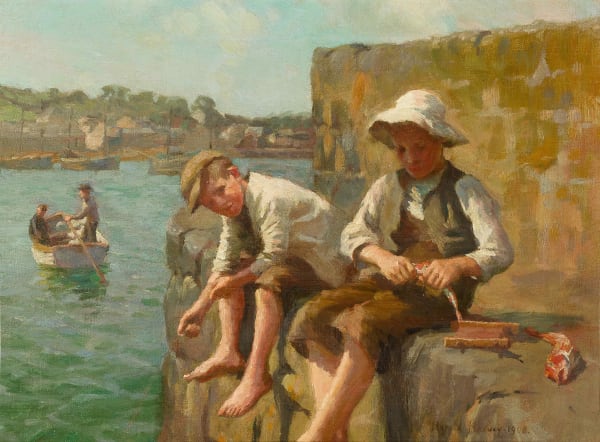Harold Harvey 1874-1941
-
 Harold HarveySeaweed Gatherers on Newlyn Beach, 1904Oil on canvas20.3 x 30.7 cm (8 x 12.1 ins.)Sold
Harold HarveySeaweed Gatherers on Newlyn Beach, 1904Oil on canvas20.3 x 30.7 cm (8 x 12.1 ins.)Sold
Framed: 35.1 x 45.5 cm (13.8 x 17.9 ins.)View full details -
 Harold HarveyCatching Gurnard, 1908Oil on canvas31 x 41cm (12 1/4 x 16 ins.)Sold
Harold HarveyCatching Gurnard, 1908Oil on canvas31 x 41cm (12 1/4 x 16 ins.)Sold
Framed: 42 x 52cm (16 1/2 x 20 1/2 ins.)View full details -
 Harold HarveyBringing in the catch, Newlyn Harbour, 1909Oil on canvas30.6 x 41.0 cm (12 x 16 1/8 ins)Sold
Harold HarveyBringing in the catch, Newlyn Harbour, 1909Oil on canvas30.6 x 41.0 cm (12 x 16 1/8 ins)Sold
Framed: 48.3 x 58.4 cm (19 x 23 ins)View full details
Harold Harvey was a prolific Newlyn artist and his style evolved in line with the Newlyn colony of which he was a central figure. In his earliest work, his palette and brushwork evidences the infuence of his mentor, Stanhope Forbes. But in the years leading up to WW1 his palette brightens and his handling of paint becomes much more impressionistic.
Harold Charles Francis Harvey was born in Penzance on 20 May 1874 to Mary Bellringer Harvey and Francis McFarland Harvey, a town bank clerk. Across all art movements and colonies that have grown up in Cornwall, Harvey shares his Cornish born and bred distinction with a small but auspicious group of artists including Peter Lanyon of the later St Ives Modernist movement. Harvey was to become the most gifted of the Newlyn School born locally and with the exception of his Paris training, spent his lifetime working in Penzance and Newlyn.
The young Harvey was home schooled before training under Norman Garstin at the Penzance School of Arts. Like so many of his soon-to-be Newlyn peers, Harvey ventured to Paris in the 1890s where he entered the Academie Julian (1894-96) and like Henry Scott Tuke, studied under Jean-Paul Laurens. Later Harvey attended the Academie Colarossi and Atelier Delecluse. Harvey like his contemporaries was much influenced by the en plein air approach to work and artistic tenets of Bastien Lepage and his long-time mentor Norman Garstin. These artists, and later Stanhope Forbes, invigorated Harvey with the principle of living among his subjects and painting them in their natural setting.
In 1896 Harvey exhibited at the inaugural exhibition of the Passmore Edwards gallery in Newlyn alongside Forbes, Langley and Garstin. His first exhibited work at the Royal Academy was ‘In a Cornish Cottage’ in 1898. He was to be a regular at the RA Summer Exhibitions throughout his life. In 1909 Harvey was elected an Associate of the Royal Cambrian Academy of Art. From 1910 he was a member of the Newlyn Society of Artists. Harvey lived until 1911 in Penzance, first in 20 North Parade and then 5 Trewartha Terrace. In 1911 he married Getrude Bodinnar, who had modelled for him and was to become an accomplished artist. The newly weds set-up home in Newlyn in Maen Cottage high on Cgywoone Hill overlooking Newlyn and Penzance.
Harold Harvey was a prolific Newlyn artist and his style evolved in line with the Newlyn artistic community of which he was a central and influential figure. In his earliest Newlyn work the young Harvey’s palette and choice of subject shows the influence of Garstin and particularly the Forbes, Stanhope and Elizabeth. In the years leading up to World War 1 Harvey’s palette brightens and his handling of paint loosens up becoming much more impressionistic. ’Bringing in the catch at Newlyn Harbour’ (1909) is such a work. Post war and during his most mature years as an artist, we see Harvey developing a distinctive and recognisable style particularly in his figurative painting. His handling of the human form becomes simplified and demonstrates an artistic affiliation with contemporaries such as Dod Procter, and in palette, his good friend Laura Knight. As the author of an article published in Colour magazine in 1920 notes, we can identify 'certain successive phases in which different influences are traceable in turn.
Starting out with a purely naturalistic realism, of which Bastien-Lepage was, via Stanhope Forbes, the inspirer, he in common with the other members of the younger Newlyn generation passes through a stage of pre-Raphaelite … to rest a while at present on the borders of 'expressionism', in which he, whilst preserving naturalism and realism in subject matter, simplifies beyond photographic accuracy'. The Harveys were close friends of Laura and Harold Knight and the Lamorna colony of artists. Harvey exhibited extensively in the Newlyn Gallery and had his first
London show in 1913. In London the artist went to have one-man shows at the Mendoza Galleries, Barbizon House and the Leicester Galleries.
In 1920, Harvey and his best friend Ernest Procter established the Harvey-Procter School in Newlyn, Cornwall. It was to continue to 1928 although it was noted by students that neither was a natural teacher both drawn more strongly by their passion for painting. In 1924 Harvey was selected to take part in the Venice Biennale.
Harold Harvey converted to Catholicism late in life and died in Newlyn on 19 May 1941 and is buried in the Roman Catholic section of Heamoor Cemetery in Penzance.
McConkey, Kenneth and Risdon, Peter (2001) Harold Harvey: Painter of Cornwall, Samson & Co,
Online resource and catalogue: Risdon Peter (2010-2020) Harold Harvey Paintings, www.haroldharvey.info,





